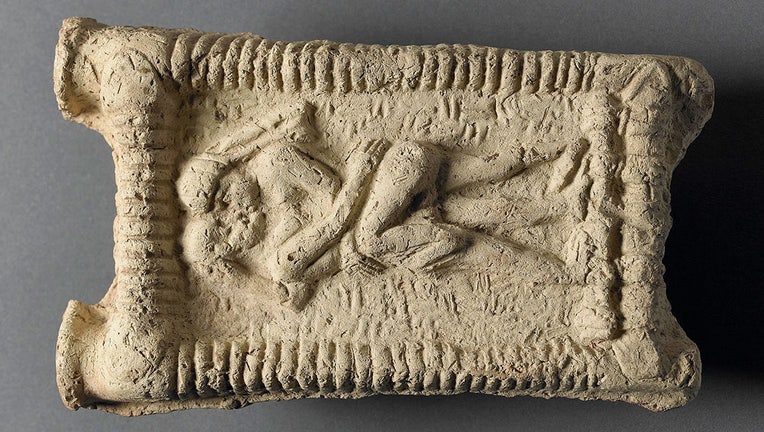The first-ever recorded kiss in history may date back earlier than we thought

Babylonian clay model showing a nude couple on a couch engaged in sex and kissing. Date: 1800 BC. (Credit: The Trustees of the British Museum)
Kissing a romantic partner on the lips is a natural and common part of our modern-day society, but much remains to be learned about its origins.
Humanity’s first-ever recorded instance of romantic kissing has been cited as a very specific geographical location in modern-day India some 3,500 years ago. However, newly published research suggests it may have actually been 1,000 years earlier than that – and in a different region.
A new article, published on Thursday in the journal Science, points to a "substantial corpus of overlooked evidence" that kissing in relation to sex was already a well-established practice 4,500 years ago in the Middle East.
"In ancient Mesopotamia, which is the name for the early human cultures that existed between the Euphrates and Tigris rivers in present-day Iraq and Syria, people wrote in cuneiform script on clay tablets," author Dr Troels Pank Arbøll, an expert on the history of medicine in Mesopotamia from the University of Copenhagen, explained in a statement.
"Many thousands of these clay tablets have survived to this day, and they contain clear examples that kissing was considered a part of romantic intimacy in ancient times, just as kissing could be part of friendships and family members’ relations," Arbøll added.
Therefore, the authors say that kissing shouldn’t be regarded as a custom that originated exclusively in any single region and spread from there.
Rather, it appears to have been practiced "in multiple ancient cultures over several millennia," Arbøll said.
Why do humans kiss?
Research has suggested that romantic kissing may occur in human sexual relationships to evaluate a potential mate’s suitability, to mediate feelings of attachment between individuals, or to facilitate arousal and initiate sexual relations.
Meanwhile, bonobos and chimpanzees – the closest living relatives to humans – both engage in kissing, according to the researchers.
This may suggest that the practice of kissing is "a fundamental behavior in humans, explaining why it can be found across cultures," said fellow author Dr. Sophie Lund Rasmussen.

New device allows couples to share a kiss from anywhere in the world
Want to send your faraway lover a kiss? A Chinese contraption with warm, moving silicon ?lips? appears to have just the answer. (Credit: KTTV)
Kissing as potential transmitter of disease
While kissing holds importance for social and sexual behavior, the practice may have also played an unintentional role in the spread of viruses among humans.
"There is a substantial corpus of medical texts from Mesopotamia, some of which mention a disease with symptoms reminiscent of the herpes simplex virus 1," Arbøll said. Herpes simplex virus type 1 (HSV-1) causes oral herpes, a now-common infection of the mouth area.
However, these ancient medical texts should not be taken at face value, as they were influenced by a variety of cultural and religious concepts.
"It is nevertheless interesting to note some similarities between the disease known as buʾshanu in ancient medical texts from Mesopotamia and the symptoms caused by herpes simplex infections," Arbøll said. "The bu’shanu disease was located primarily in or around the mouth and throat, and symptoms included vesicles in or around the mouth, which is one of the dominant signs of herpes infection."
Speaking to Smithsonian Magazine, Arbøll said he believes that kissing "has played a role in disease transmission, but it seems to have been more of a constant way of transmission."
"Our suggestion is that because it seems to have this wide distribution in the ancient world, it didn’t rapidly accelerate a disease in any given population," Arbøll told the outlet.
RELATED: Chinese 'kissing' device allows long-distance couples to virtually smooch
This story was reported from Cincinnati.

